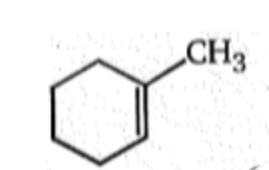Which of the following reagents will be able to distinguish between 1-butyne and 2-butyne?
1. NaNH2 2. HCl 3. O2 4. Br2
निम्नलिखित में से कौन सा अभिकर्मक 1-ब्यूटाइन और 2-ब्यूटाइन के मध्य विभेद करने में सक्षम होगा?
1. NaNH2 2. HCl 3. O2 4. Br2
Which of the following reactants is suitable for preparation of methane and ethane by using one step only?
(a) H2C = CH2
(b) CH3OH
(c) CH3-Br
(d) CH3-CH2-OH
केवल एक पद का उपयोग करके मेथेन और एथेन को निर्मित करने के लिए निम्नलिखित में से कौन सा अभिकारक उपयुक्त है?
(a) H2C = CH2
(b) CH3OH
(c) CH3-Br
(d) CH3-CH2-OH
Which of these will not react with acetylene?
1. NaOH 2. Amm.
3. Na 4. HCl
एसिटिलीन के साथ इनमें से कौन अभिक्रिया नहीं करेगा?
1. NaOH 2. अमोनियामय
3. Na 4. HCl
When was hydrolysed a gas was obtained. It had a garlic odour due to phosgene present as impurity. The gas was passed through ammoniacal solution of , a red ppt. was obtained. The gas was:
1. ethylene 2. propyne
3. acetylene 4. ethane
जब को जलयोजित किया गया तो एक गैस प्राप्त हुई। इसमें अशुद्धि के रूप में फॉस्जीन की उपस्थिति के कारण लहसुन की गंध थी। गैस को अमोनियामय विलयन के माध्यम से पारित करने पर, एक लाल अवक्षेप प्राप्त हुआ। कौन सी गैस थी?
1. एथिलीन 2. प्रोपाइन
3. एसिटिलीन 4. एथेन
An alkene, obtained by the dehydration of an alcohol (A), on ozonolysis gives two molecules of acetaldehyde for every molecule of alkene. The alcohol (A) is:
(a) (b)
(c) (d)
एक एल्कोहॉल (A) के निर्जलीकरण द्वारा प्राप्त एक एल्कीन, ओजोनोपघटन पर एल्कीन के प्रत्येक अणु के लिए एसिटैल्डिहाइड के दो अणु देती है। एल्कोहॉल (A) क्या है?
(a) (b)
(c) (d)
The reaction,

(a) sulphonation (b) dehydration
(c) alkylation (d) decomposition
अभिक्रिया

(a) सल्फोनीकरण (b) निर्जलीकरण
(c) ऐल्किलन (d) अपघटन
 Product; Product is:-
Product; Product is:-
(a) 



उत्पाद क्या है?
(a) 


The shortest bond distance is found in
(a) diamond (b) ethane
(c) benzene (d) acetylene
किसमें सबसे छोटी बंध दूरी पायी जाती है?
(a) हीरा (b) एथेन
(c) बेंजीन (d) एसिटिलीन




 2.
2. 
 4.
4. 






